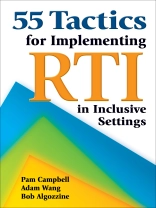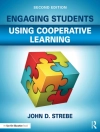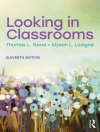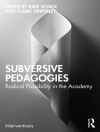‘This exceptionally practical book can make a real difference in every classroom. Educators who follow the wisdom in this book and apply the specific tactics will ensure success for all students. The authors present a healthy attitude toward educators taking personal responsibility to teach for learning.’
—Wanda Oden, Assistant Superintendent
Kingman Unified School District No. 20, AZ
‘Teaching diverse learners in inclusive settings can be an overwhelming task. This book is my bible for effectively completing multiple tasks with my students, who often have varying needs.’
—Tina M. Guard, Graduate Student and Teacher
University of Nevada
Boost academic achievement for all students in your inclusive classroom!
As schools implement RTI in general education settings, educators need easy access to information about effective teaching and intervention tactics for the diverse learners in their classrooms. This resource provides all teachers, regardless of level, experience, or area of specialization, with effective instructional strategies for students with or without disabilities and across grade levels and content areas.
Drawing from evidenced-based models of instruction, 55 Tactics for Implementing RTI in Inclusive Settings is organized around four components of instruction—planning, managing, delivering, and evaluating. In addition to 55 classroom-tested, how-to tactics backed by research, this book includes:
- Accommodations and modifications to adapt tactics to meet individual instructional needs
- Illustrations showing how to implement tactics within each tier of a three-tier RTI framework
- Relevant examples from teachers in the field
- A wealth of reproducibles, worksheets, and forms for immediate use
- References and additional readings
This valuable guide provides the support teachers need to meet the increasingly diverse needs of today′s classrooms and ensure that all students have the opportunity to succeed.
İçerik tablosu
Preface
Acknowledgments
About the Authors
Part I. Planning Instruction
1. Decide What to Teach
Assess to Identify Gaps in Performance
Establish Logical Sequences of Instruction
Consider Contextual Variables
2. Decide How to Teach
Set Instructional Goals/Establish Performance Standards
Choose Instructional Methods and Materials
Establish Grouping Structures
Pace Instruction Appropriately
Monitor Performance and Replan Instruction
3. Communicate Realistic Expectations
Teach Goals, Objectives, and Standards
Teach Students to Be Active, Involved Learners
Teach Students Consequences of Performance
Part II. Managing Instruction
4. Prepare for Instruction
Set Classroom Rules/Communicate and Teach Classroom Rules
Communicate Consequences of Behavior
Handle Disruptions Efficiently
Teach Students to Manage Their Own Behavior
5. Use Time Productively
Establish Routines and Procedures
Organize Physical Space
Allocate Sufficient Time to Academic Activities
6. Establish Positive Environments
Make the Classroom a Pleasant, Friendly Place
Accept Individual Differences
Establish Supportive, Cooperative Learning Environments
Create a Nonthreatening Learning Environment
Part III. Delivering Instruction
7. Present Information
Gain and Maintain Attention
Review Prior Skills or Lessons
Provide Organized, Relevant Lessons
Show Enthusiasm and Interest
Use Rewards Effectively
Consider Level and Student Interest
Model Thinking Skills
Teach Fact-Finding Skills
Teach Divergent Thinking
Teach Learning Strategies
Develop Automaticity
Vary Opportunities for Practice/Vary Methods of Practice
Monitor Amount of Work Assigned
8. Monitor Presentations
Give Immediate, Frequent, Explicit Feedback/Provide Specific Praise and Encouragement
Model Correct Performance
Provide Prompts and Cues
Check Student Understanding
Monitor Performance Regularly/Monitor Performance During Practice
Use Peers to Improve Instruction
Provide Opportunities for Success/Limit Opportunities for Failure
Monitor Engagement Rates
9. Adjust Presentations
Adapt Lessons to Meet Student Needs
Provide Varied Instructional Options
Alter Pace
Part IV. Evaluating Instruction
10. Monitor Student Understanding
Check Understanding of Directions
Check Procedural Understanding
Monitor Student Success Rate
11. Monitor Engaged Time
Check Student Participation/Teach Students to Monitor Their Own Participation
12. Keep Records of Student Progress
Teach Students to Chart Their Own Progress
Regularly Inform Students of Performance
Maintain Records of Student Performance
13. Use Data to Make Decisions
Use Student Progress to Make Teaching Decisions
Use Data to Decide If More Services Are Warranted/Use Student Progress to Decide When to Discontinue Services
Appendix A: RTI Accommodations/Modifications Checklist
Appendix B: RTI Accommodations/Modifications Worksheet
Appendix C: Documentation of RTI Accomodations/Modifications
References
Additional Readings
Selected Internet Resources: RTI Accomodations/Modifications
Index
Yazar hakkında
Bob Algozzine is a professor in the Department of Educational Leadership at the University of North Carolina and project codirector of the U.S. Department of Education-supported Behavior and Reading Improvement Center. With 25 years of research experience and extensive firsthand knowledge of teaching students classified as seriously emotionally disturbed, Algozzine is a uniquely qualified staff developer, conference speaker, and teacher of behavior management and effective teaching courses. He is active in special education practice as a partner and collaborator with professionals in the Charlotte-Mecklenburg schools in North Carolina and as an editor of several journals focused on special education. Algozzine has written more than 250 manuscripts on special education topics, including many books and textbooks on how to manage emotional and social behavior problems.












